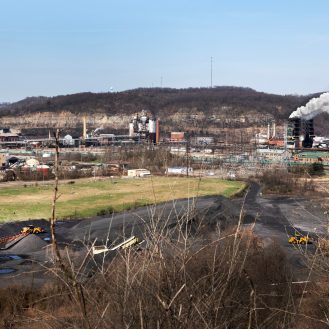ASTOR, Fla.—Dana Land and his wife, Ava, live on a bend in the St. Johns River, the water lapping not far from their back door. For a dozen years, the river brought them peace and joy. Then last fall, Hurricanes Ian and Nicole transformed the waterway into a threat that flooded their home for weeks.
As a new Atlantic hurricane season begins on June 1, the Lands are still working on repairs of their two-story wood frame house. “I hope we don’t have double back-to-back hurricanes again, but I’ve made these changes to try to make life livable here the next time,” Dana Land said.
While the Lands press ahead, however, the confluence of two important climate factors has meteorologists puzzling over what this hurricane season could bring.
“What makes this forecast hard is that we are potentially looking at something we haven’t seen before,” said Phil Klotzbach, a senior research scientist at Colorado State University’s Department of Atmospheric Science. “We have a strong El Niño but a record or close-to-record warm Atlantic. That makes it tough just because we haven’t seen that historically.”
Normally, scientists expect a season of near- to below-average hurricane activity along the Atlantic seaboard when their climate monitoring indicates that warm water in the equatorial Pacific is pushed eastward, in the climate pattern known as El Niño. Yet the wild card this year is the conjunction with abnormally warm surface temperatures in the eastern and central tropical and subtropical Atlantic, which can bolster hurricane activity.
The suspense is considerable for Americans who suffered serious damage last year. But for now, the National Oceanic and Atmospheric Administration’s Climate Prediction Center projects a 40 percent chance of a near-normal Atlantic hurricane season, with 12 to 17 named storms. Of those, five to nine could become hurricanes, it estimates, including one to four major ones of category 3, 4 or 5 strength packing sustained winds of 111 miles an hour or more.
The center also calculates a 30 percent chance of above-normal activity and a 30 percent chance of below-normal activity in the hurricane season, which ends on Nov. 30.

While the NOAA data point most strongly to less activity than in recent years, the agency is taking precautions. It says it is extending its hurricane outlook chart from five days to seven and introducing a new hurricane forecast model, along with other steps to improve communications with emergency managers and the public about potential risks.
At Colorado State, Klotzbach’s fellow researchers expect 13 named storms, with six becoming hurricanes and two morphing into major hurricanes. The team estimates that hurricane activity will be about 80 percent of the average recorded between 1991 and 2020. By comparison, last year’s activity was about 75 percent of the norm.
The 2022 season will be best remembered for Ian, which ranks as the third-costliest hurricane in U.S. history after Katrina in 2005 and Harvey in 2017, according to NOAA.
After flattening swaths of southwest Florida in September, Ian left widespread flooding across the state’s interior, causing $113 billion in damage and 156 deaths. Researchers at Stony Brook University in New York and the Lawrence Berkeley National Laboratory in California concluded that climate change increased the hurricane’s rainfall rates by more than 10 percent.
Hurricane Fiona, another September storm, caused devastating flooding in Puerto Rico. Then Nicole, a rare November hurricane, arrived and inundated areas of Florida that Ian had spared.
The likely development of an El Niño therefore comes as welcome news for many hurricane-weary Floridians. But the climate pattern’s effects elsewhere around the globe are strikingly varied.
When an El Niño takes shape, the interaction between warm waters in the Pacific and the atmosphere causes shifts in air currents five to 10 miles above sea level. These shifts can lead to milder, wetter winters in the U.S. and droughts in Australia and India. The Pacific gets more hurricanes, and the Atlantic gets fewer: That’s because these shifts lead to increased wind shear or atmospheric choppiness over the Atlantic, which can weaken or break apart hurricanes.
But this year the ocean’s surface temperatures have warmed more rapidly than normal, and scientists are not entirely sure why, said Kim Wood, associate professor in Mississippi State University’s Department of Geosciences. That prospect is worrisome.
“The source of energy for the thunderstorms that power a hurricane is the ocean,” Wood said. “When the ocean is warmer, there is more energy.”
Keep Environmental Journalism Alive
ICN provides award-winning climate coverage free of charge and advertising. We rely on donations from readers like you to keep going.
The temperatures have warmed so fast that climate change cannot be the only reason, experts say. Scientists suggest that other factors are at play, like weaker winds, which would reduce mixing between the Atlantic’s surface and cooler depths.
A record swath of sargassum seaweed that gained media attention recently for invading idyllic beaches in Florida, Mexico and the Caribbean region would prevent sunlight from penetrating the depths, warming the surface, said Mark Bourassa, associate director of the Center for Ocean-Atmospheric Prediction Studies at Florida State University.
“It’s a huge change,” Bourassa said. “We just haven’t seen this kind of stuff before. So we don’t know what it will do to the hurricane season, and we get so few hurricanes per year. We need several seasons. We need 10 seasons like this to get a feel for how these high temperatures will impact hurricane season.”
Atlantic surface temperatures in April were 2 degrees to 4 degrees Fahrenheit above normal, said Allison Wing, an associate professor in Florida State University’s Department of Earth, Ocean and Atmospheric Science.
“It’s warm enough for the hurricanes to care about it,” Wing said, adding: “If you’re going for a swim, you’re like, ‘Well, it was always warm, and it still feels warm.’ But it’s big enough that it definitely matters for the hurricanes.”
It’s possible that the warmer Atlantic surface temperatures combined with the El Niño will mean fewer hurricanes but that those that do develop will be stronger, said Jill Trepanier, a hurricane climatologist at Louisiana State University.
“Models aren’t going to show that as easily because our ability to model intensity is not as good as our ability to model frequency and track, and that is because of the data,” Trepanier said. “I do think you should be ready for an intense storm if one is coming toward you. Don’t expect it to be a baby. The waters are too hot.”
Noting that Ian and Nicole were jointly responsible for unprecedented rainfall in Florida, experts say that hurricanes are also likely to become even rainier because a warmer atmosphere can hold more moisture. Warmer sea surface temperatures also can cause hurricanes to intensify more rapidly, and rising sea levels can lead to more damaging storm surges. It is not clear, however, whether climate change can cause more frequent hurricanes.
“All you need is one to impact your location, and then all of a sudden it is a catastrophe for you,” Wing said. “Even last year, it wasn’t a crazy year. But we had Ian and one or two other storms that were bad and made landfall in highly populated areas.”
Some 1,149 households in Florida remain displaced by Ian and have found shelter under the Federal Emergency Management Agency’s temporary housing program. The National Flood Insurance Program has paid more than $4 billion toward claims associated with Ian and Nicole.
For Astor, a tiny community some 60 miles northwest of Orlando, the one-two punch brought by last year’s hurricane season was harrowing. The St. Johns is Florida’s longest river, and a few weeks after Ian struck on Sept. 28, residents were just beginning to feel the relief of receding waters when Nicole arrived on Nov. 10 and dumped more rain.
The two hurricanes combined brought more rain last year than some areas in Florida had seen in centuries or possibly longer, scientists say, causing cataclysmic flooding. At one point, a neighbor of the Lands spotted a manatee, an outsize mammal with a paddle-shaped tail that normally never leaves the water, eating grass in the backyard. It would be close to Christmas before the river was fully back within its banks.
The Lands’ home took on about six inches of water, but Dana Land says he would never consider moving away from his beloved river. Instead he is not only repairing the house but also adapting it. By raising a backyard deck and adding sand fill across the rest of the yard at an elevation above the floodplain, he hopes he can protect his home from future storms and flooding.
“I’m not afraid of the water,” said Dana Land, who retired about two years ago from a local sonobuoy factory. “The river forced itself in, you know? But I think we will be better for it.”
The repairs have taken up most of his time since the water receded. He has also cleaned and bleached the house’s first floor, and ripped out some of the walls and begun replacing them. The Lands also own a deck boat, a houseboat, two kayaks, two sailboats and a canoe. “We’ve always been water people,” he said.
He hopes that he and his wife will enjoy the St. Johns River even more once the repairs are complete.
All the same, given the reality of hurricane risks, Land said, “I’m hoping that the changes that I’ve made will be enough to keep the water in the backyard and not in the house.”









